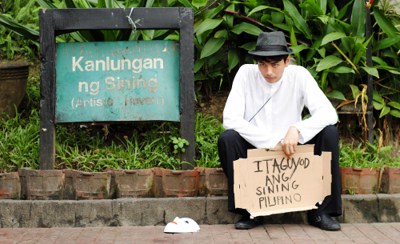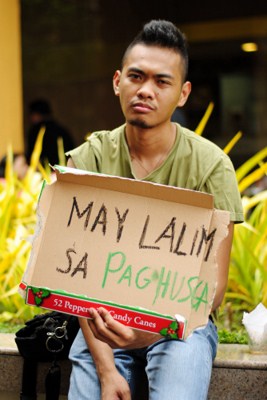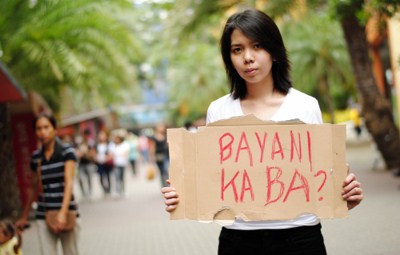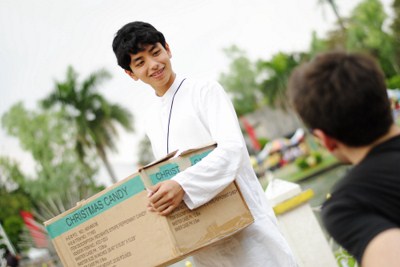 Starving artists: we hear much about these persecuted souls who dedicate their lives to pursue their art and advocacies, forfeiting steady income and financial stability for the brush, pen, chisel and the Mind. They go on for days without food, and depend on dregs of coffee for sustenance while peddling their works, relying entirely on passion to take the road less traveled.
Starving artists: we hear much about these persecuted souls who dedicate their lives to pursue their art and advocacies, forfeiting steady income and financial stability for the brush, pen, chisel and the Mind. They go on for days without food, and depend on dregs of coffee for sustenance while peddling their works, relying entirely on passion to take the road less traveled.
So how exactly do these people face the harsh economic and otherwise mundane realities that beset them? To discover the obstacles a penniless artist faces on a daily basis, this month, The Menagerie sectioned tried to live as struggling artists for a day.
Writers Betina, Juan and Niño, declared themselves as artists without a centavo for food let alone, transportation. Therefore, they needed to collect solicitations for their cause. Carrying cardboard placards advocating art, critical thinking, and nationalist sentiments, the three set a solicitations spot in a place of public traffic, to see if they could attract donations from patrons of Philippine artists. The writers accepted the mission, despite the difficulty of the task.
Gathering at DLSU’s South Gate at 8:30 in the morning, Juan, Niño and Betina made final preparations before heading to a place of public traffic. The trio made the criteria for their ideal location. The place had to have the following: (a) people from all walks of life; (b) likely patrons of art; and (c) picturesque scenery. The group decided to go to the Mall of Asia (MoA).
Making the most of everything they had, they disassembled cardboard boxes to make signs using oil pastels to voice out their advocacy. The signs contained expressions like one that read: “Itaguyod ang sining Pilipino”. The writers were certain that this was one way to attract attention.
After all the preparations, the trio started the walk to MoA from DLSU. Naturally, they went by foot since transportion would normally be an issue for starving artists. The writers did not see it as a problem. The three knew, however, that it would take much of their time. As they walked, the trio felt excited, anxious and uncertain, all at the same time.
The road to MoA seemed never-ending under the scorching sun. Possibly due to fatigue and heat from the taunting sun, the trio realized that they were lost after passing landmarks such as the Cultural Center of the Philippines and Hotel Sofitel. To their disappointment, they apparently took a wrong turn towards a seemingly dead end. They took the turn after passing an abandoned theater, which caught their attention and turned their sense of direction. The road they followed lead them to a dead end, which, as Niño noticed, was located beside a shabby gray building; the GSIS’ Museo ng Sining. As they turned around and found their way to the main road, the three pondered on the ironies that the museum held: imagine, artists left to scramble for space in a dilapidated gray museum in the middle of nowhere, with their commission insignificantly trickling from government insurance. A true dead end.
Two hours later, after the intense pre-noon heat, buckets of sweat, tired legs and ironic, disheartening realizations from their accidental detour, the artists managed to find the way to the MOA grounds, or rather, the fringes of it: the long cobbled stretch of stone and sea wall, where families, lovers, tourists, large groups of teenagers and policemen walked by watching the ships, the sea, and the low, snaring waves. The trio sat down for a few minutes on the cobble to rest. They finally set up as 10:30 am struck. While primary solicitors Juan and Niño took out the placards for their cause, Betina set up the ‘stall’ proper: an unfurled malong with a collection of her photos, for sale at P15.00 each.
The group, due to their placards and evident distinction from the surroundings, got not only curious glances; a security guard even took notice of them. The guard came over, bearing down on the radicals as their hearts held back beats. Niño and Betina exchanged glances as panic washed over their faces. Juan looked back at the two and told them that there was nothing to be worried about. A few moments later, the security guard poked at their box of placards and demanded the group to deliver an explanation.
As Niño and Betina hid the photos previously displayed, Juan explained to the guard that the stall was a way of gauging public opinions on art (which was partly true, except he did not mention anything about solicitations). Unfazed, the guard ignored the explanation and asked them which faith they were preaching for, assuming that the whole thing was about religion. Yet again, Juan repeated his initial statements.
Eventually, the guard understood Juan. With an inkling of their motivations, the guard elaborated that the property was semi-public and semi-private, meaning that they could go there freely, but they cannot conduct any of the activities they were doing. The trio would have to secure a permit from the mall administration if they wanted to set up a stall there. While all of this was going on, passers-by stole a glance or two at the group.
To take in the stares and to go on with their journey took the courage and strength from the writers. The group wondered how others saw them.
The guard eventually advised them to try their luck at Luneta Park, a truly public park, where they could do anything, without a permit.
The writers realized that being shooed away before making any money left them quite crestfallen. In some way, it felt discouraging to relocate. So much time had been lost travelling to their first location, and now, they just had to relocate again.
Still adjusting to the role of struggling artists, the hungry trio was still unsure of what path to take. Was there something they did not know? Maybe there was a certain trick that struggling artists use to sell their art?
Having lost at least five hours from travel and set-up, and still without sales, there was only one thing left to do – walk the additional 2 hours to Luneta Park. The group pondered…that maybe it IS about the money.
With hunger pains in their stomachs, the three wondered what it felt like to have hunger pains everyday.
Luneta Park was alive and vibrant when the group arrived. They were extremely exhausted, hungry and sleepy. One of them even joked that they were nearly dead. On a lighter note, they were greeted with a mass of people engaged in their early afternoon activities – students rehearsing a dance routine, couples affectionately strolling while holding hands, foreigners taking their first ride on a kalesa, and families spending quality time with each other on picnics. The park, to their surprise, was a place of commerce too. There were many small stalls selling a variety of food, trinkets, and memorabilia. To them, the traffic of people and the visibility of business provided the extra push the trio needed to accomplish their goal of attaining solicitation. “Positivity is the key!” Betina exclaimed. Niño and Juan nodded in agreement. They convinced themselves that there was still hope.
They set their solicitations station adjacent to a sign that read ‘Kanlungan ng Sining’ (Art’s Cradle), where there was a considerable traffic of people. They hoped that their paraphernalia – their thought-provoking signage, and their portrayal as artists – would be enough to drive people’s curiosity for a purchase (or at least a few peso coins might be thrown into the solicitations hat). But that was basically all they had – hope.
Passers-by stared at their signs, glimpsed at Betina’s pictures, and moved away from the writers. Some would smile at them tentatively, but the fact remained that the trio were only strangers to these park-goers. In the eyes of the people, they were only a group wanting to beg, without a deeper purpose other than profit.
If only the people knew, if only they were curious enough to inquire. But no one took the bait, and the artists’ profit remained at zero. It was apparent that art was under appreciated, and only a few dared to take a peek into the works of the artists.
At the end of the day, when the sun was starting to set, they all agreed that it was time to say goodbye. Even though they did not gain any solicitations, the trio did not feel defeated because of all the insights they had gained from what seemed to be a fruitless journey. On their way back to Taft, they all agreed that being a struggling artist was (and probably is) not easy. It takes so much courage, strength, and passion to believe in art, and even then, it is a huge risk. What is heart warming, however, is that there are still some people who take the risk, despite the sacrifices.
As Betina, Niño and Juan walked back penniless and seemingly defeated, ending their journey as struggling artists at 4:03 pm, there they still were: starving, starving but still striving. Such was the artists’ fate.



